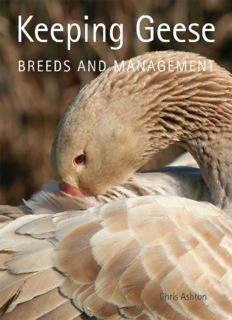
Keeping Geese: Breeds and Management PDF
Preview Keeping Geese: Breeds and Management
Keeping Geese BREEDS AND MANAGEMENT Keeping Geese BREEDS AND MANAGEMENT Chris Ashton THE CROWOOD PRESS First published in 2012 by The Crowood Press Ltd Ramsbury, Marlborough Wiltshire SN8 2HR www.crowood.com This e-book first published in 2015 © Chris Ashton 2012 All rights reserved. No part of this publication may be reproduced or transmitted in any form or by any means, electronic or mechanical, including photocopy, recording, or any information storage and retrieval system, without permission in writing from the publishers. British Library Cataloguing-in-Publication Data A catalogue record for this book is available from the British Library. ISBN 978 1 78500 056 0 Contents Preface and Acknowledgements Part I: History and Origins 1. The Origins of the Domestic Goose Part II: Setting Up 2. Why Keep Geese? 3. How to Start Part III: Understanding Geese 4. Goose Anatomy 5. The Life Cycle and Care of Feathers 6. Goose Diet and Digestion Part IV: The Breeds of Geese 7. Introduction to the Breeds 8. Asiatic Geese 9. White Geese 10. Sebastopol Geese 11. Auto-Sexing Geese 12. Pied Geese 13. Toulouse Geese 14. Buff Breeds 15. Fighting Geese Part V: Keeping Adult Geese 16. Management of Adult Stock 17. Goose Behaviour Part VI: Breeding and Rearing Geese 18. Eggs and Natural Incubation 19. Incubators 20. Rearing Goslings 21. Commercial Geese – Table Birds Part VII: Keeping Geese Healthy 22. Ailments and Diseases Appendix: Punnet Squares References Useful Contacts Index Preface We encountered goose keeping by accident; nothing was planned. The hobby just grew from a present of two small goslings for my daughter’s birthday. Our geese were never considered for the table, yet in general they do have many values and uses. This is what the book is primarily about. One reputation was quickly dispelled. They are not the farmyard tyrants of myth and memory. We found them to be intelligent, responsive, sociable and highly absorbing, especially if reared from goslings. They offer a real window into the ‘wisdom of birds’: close contact with geese really does open up a new perspective on avian intelligence. This book tries to put the record straight. From a purely practical point of view, geese are the ideal food converters in a large garden, excellent lawnmowers and fascinating pets. They do well on a diet consisting largely of grass, and are cheaper to keep than other poultry which need a higher proportion of grain in their diet – an important consideration in an overcrowded world. Acknowledgements Limited written information was available in the UK about keeping and rearing geese when we first acquired these birds. This book and Domestic Geese (1999) were the result of shared experiences with other goose keepers over the last thirty years. Keeping, breeding and exhibiting these birds has led to an accumulation of information which I hope other keepers will find useful. Special thanks are due to John Hall for his help and advice on the breeds, and to Tom Bartlett for his expertise and sheer enthusiasm for waterfowl at Folly Farm in the Cotswolds in the late 1900s. When we started with geese, these experts led the way. Other goose breeders in the UK and abroad have also contributed to the experiences, knowledge and photographs in this book: Peter van den Bunder, Bart Poulmans, Sonja Sauwens and Gerard Lambrighs of the Flemish Waterfowl Association; Andrea Heesters and Peter Jacobs, Hans Ringnalda and Sigrid van Dort, plus Kenneth Broekman of Holland; Michael Peel, Hamish Russell and Dr Harry Cooper (Australia’s favourite vet); Bob Hawes from the USA for his continued support and detailed knowledge of the history and genetics of domestic geese; also Lori Waters, who has a real eye for photography, with her Runners and Sebastopols, and a passion for the birds. Visiting shows in Germany and judging in France, Holland and Australia has also provided me with an insight into how the goose breeds have travelled the world, and how they continue to fascinate as a hobby bird and subject for photography. I am also grateful to Paul-Erwin Oswald, Mark Hoppe and Helene Towers for helping with translations and queries regarding the long history of geese in Germany. Last, but most of all, I am grateful for the involvement with the geese over the years from both my daughter, Tig, and husband, Mike Ashton, who also looked over the manuscript. Without family involvement, keeping a multiplicity of birds is almost impossible. These birds have been part of the family for such a long time, and have brought us into contact with so many like-minded friends.
Description: